Tell me something, marketers. Are you satisfied with the state of B2B content marketing?
According to 980 of you, the answer is likely “no,” given how much more you say you want in the Content Marketing Institute’s annual B2B Content Marketing Benchmarks, Budgets, and Trends: Outlook for 2025, conducted with MarketingProfs and sponsored by The MX Group.
More what? Well, resources, sure. That’s a given.
Also, more people. Clarity of purpose. Goals. Technology. And maybe more inspiration.
Without these, many of you feel just meh about your work:
- A whopping chunk (58%) of B2B marketers rate their content strategy as merely “moderately effective.”
- Nearly half of those say their strategy struggles because they lack clear goals.
- Only one in three say they have a scalable model for content creation.
- The biggest challenge? A lack of resources.
So what else is new? In the 15 years CMI and MarketingProfs have conducted this survey, these same limitations surface again and again.
As Robert Rose, CMI chief strategy advisor, said after looking through these findings, “One of the most remarkable things about this year’s research is how unremarkable it is. Frustration and simple maintenance have become the status quo in B2B marketing.”
But, while many find themselves simply treading water, a group of top performers has found a way to surge ahead. They’ve figured out how to understand their audience’s needs, produce high-quality content, and use AI to create more efficient workflows.
Let’s dive into the results — including what separates meh from marvelous. (Use the Table of Contents to navigate to the sections that interest you most. You’ll find Robert’s suggestions on what to do about all of this in Action steps.)
Team structure
Are organizations dedicating enough people to their content initiatives? When we asked B2B marketers how content marketing work gets done within their organizations, most (76%) have a dedicated content marketing team or person on staff. And the larger the organization, the more likely it was to have dedicated resources.
But most (54%) who have a dedicated content marketing team or staff say the team is small, consisting of two to five people.
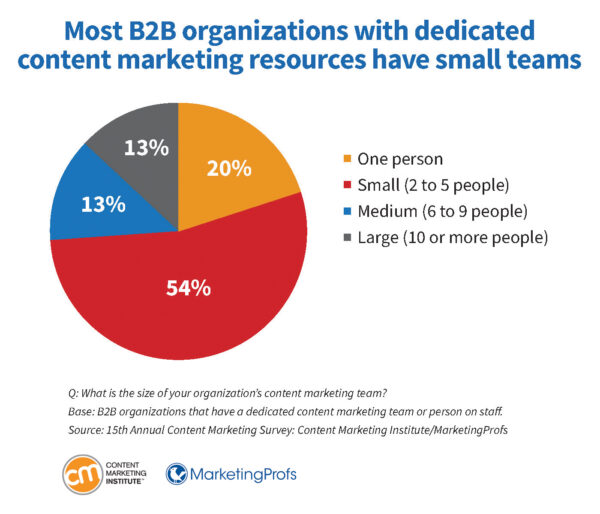
What if there’s no dedicated team or person?
Believe it or not, 24% of B2B respondents say they don’t have dedicated content marketing teams or staff. When we asked that group how the work gets done, 50% say they rely on multiple content teams (e.g., department, brand, or product), 7% say they use an outside content marketing agency/vendor, and 43% list “other.”
Those who chose “other” offered explanations that ranged from two people with multiple responsibilities, including content, to whoever was available.
And therein lies a problem: While staff may handle content-related tasks, no one is responsible for leading content marketing as a strategic approach. Reactive, scattershot content tactics aren’t likely to generate any meaningful (or consistent) results.

Content strategy effectiveness
Next, we asked the 95% of B2B marketers who have a content strategy to rate its effectiveness. Less than a third (29%) call it extremely or very effective. Well over half (58%) say it is moderately effective, while 12% say it is not very effective, and 1% say it is not at all effective.
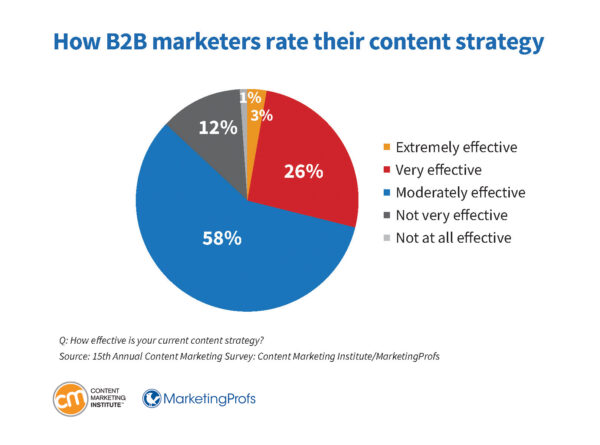
Among those who rate their strategy as moderately effective or worse, 42% cite a lack of clear goals as the reason why they didn’t rate it higher.
Other reasons include:
- Not tied to customer journey (39%)
- Not data-driven (35%)
- Ineffective audience research (29%)
- Other (26%)
- Unrealistic expectations (23%)
- Emphasizes content quantity over quality (20%)
- Failure to iterate/adapt (18%)
- Inconsistent brand voice (17%)
- Poor content quality (10%)
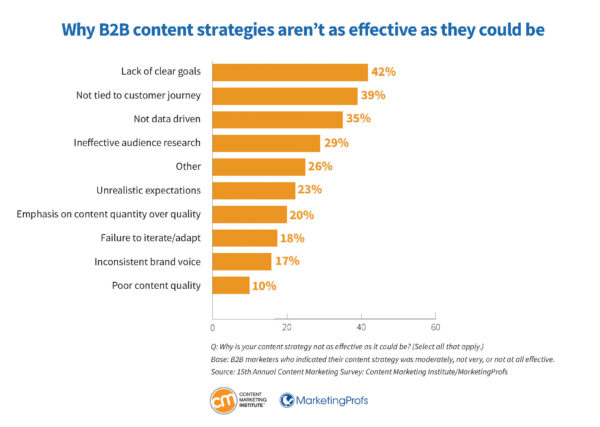
Those who selected “other” cite the following problems:
- Lack of resources (time, budget, and people)
- Lack of leadership (no clear direction)
- Internal silos (inefficiencies and conflicting priorities)
Their comments include:
- “Constantly shifting messaging in response to shifting leadership priorities”
- “Lack of budget to develop content and too many cooks in the kitchen”
- “Lack of resources with strategic content planning and development skills”
- “Limited time and resources to focus on prioritizing content”
- “Too many diverse business units”
- “Too many brands and products without clear priority”
- “Lack of time to focus on long-term strategy due to short-term demands by the organization. Long-term strategic content marketing projects are not prioritized, even though they would move the needle for the overall brand; not enough people/resources and high volume of work.”
Content marketing challenges
When we asked about challenges not related to content creation, the most often cited was lack of resources (54%). Last year, about the same amount (58%) said the same. It’s a problem that just doesn’t go away.
Measuring the results of content efforts (a new option in this year’s survey) came in second, cited by 47%. Aligning content with the buyers’ journey remains a challenge, as 45% indicate it’s a problem this year vs. 48% the previous year.
Another challenge that’s not going anywhere — aligning content across sales and marketing (43% cite it as a challenge this year compared with 45% the previous year).
Also new to the list this year was communicating across organizational silos, with 40% indicating that it’s challenging.
B2B marketers appear to have gained some ground with:
- Managing workflow issues/content approvals process: 33% mention it this year, down from 41% the previous year
- Keeping up with new technologies: 27% cite it this year, down from 34% the previous year
- Accessing subject matter experts: 33% indicate it’s challenging vs. 39% the previous year
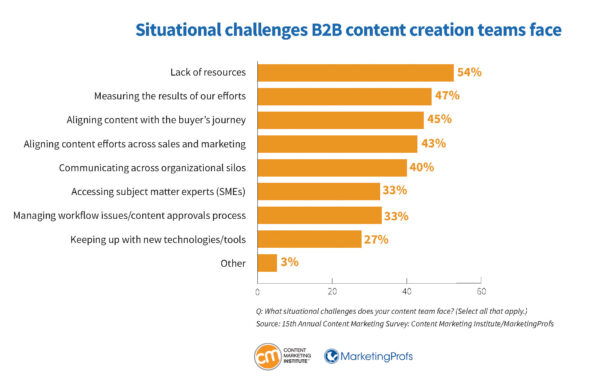
Creating content that prompts a desired action isn’t easy
Content creation challenges look different for B2B marketers than the previous year. Based on our conversations with marketers, we added a new option to the list of challenges: Creating content that prompts a desired action.
Turns out, our observation was right. More B2B marketers (55%) cite it as a challenge than any other option.
We asked Ann Handley, chief content officer at MarketingProfs, why B2B content teams struggle with this. Here’s what she says:

Chief Content Officer
MarketingProfs
My question is … how are you measuring this? Or, rather, how do you know it’s not creating the action you want to inspire?
B2B content is part of a complex matrix of various touchpoints, seen and unseen, including word of mouth, dark social, that one guy who mentioned your brand on LinkedIn. We want to believe the purchase journey is a straight, orderly line of attribution: Read blog post. > Hit demo. > Buy.
But B2B — or any marketing — doesn’t work that way. It’s less straight line, more squiggly scribble that overlaps in oddball ways. Less straightforward path; more conspiratorial crime scene investigation board.
What marketers can do about it is to rethink the messy muddle of attribution to think about more meaningful ways to know what’s ‘working.’
Not how many people downloaded a white paper … but how many then signed up for your email newsletter? And then, how many of them wrote back to you when you told a story in the last issue about a specific problem they have? What did existing customers tell you worked the last time you spoke with them? Rethink off-the-shelf metrics (because there is no shelf).
Other content creation challenges
Last year, most B2B marketers (57%) cited creating the right content for the audience as a challenge. This year, only 40% did. That may indicate that B2B marketers have improved or focused more on crafting better-targeted content in the last 12 months.
Fewer marketers mention differentiating content and creating it consistently as top challenges this year compared to last (43% and 42% respectively this year, down from 54% for both last year).
Creating enough content is still a challenge for 39% this year. Last year, we distinguished between creating enough content to keep up with internal demand (34%) and external demand (30%). Content repurposing is a challenge for 37%. As it was a new option this year, a comparison is not available.
And here’s a somewhat surprising change given recent SEO developments: Only 35% of marketers cite optimizing for SEO as a top challenge this year, down from 45% last year. Perhaps even more surprising? Only 27% said creating quality content is a challenge, down from 44% last year.
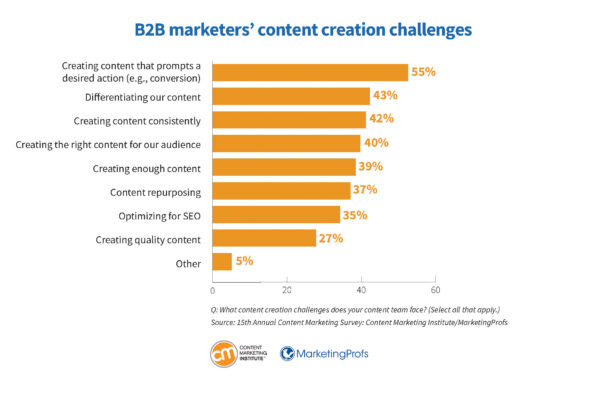
B2B marketers’ tech stacks lack these essentials
When we asked B2B marketers which capabilities, if any, are missing from their marketing tech stack, nearly half (47%) say they lack efficient lead generation and nurturing processes. The same number say they do not have streamlined marketing data management and reporting.
Almost as many (45%) said they lack the tech to support data-driven decision-making. Forty-four percent say the ability to automate repetitive tasks and workflows is missing, and the same number say advanced personalization options aren’t available. Forty-one percent lack easy access to enterprise analytics, and 39% say strong alignment between sales and marketing systems isn’t possible. Only 8% say no capabilities are missing from their tech stack.
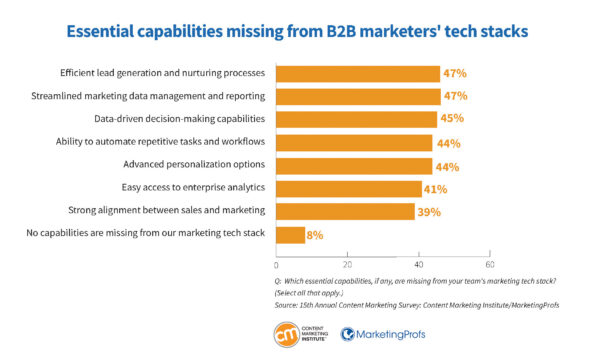
Too few have the right technology — or use it to its potential
It’s no wonder B2B marketers struggle with essential tech capabilities: Only 26% of those surveyed think their organization has the right technology to manage content across the organization. That’s worse than last year when 31% said the same thing.
Also challenging is the percentage of marketers who say they have the technology but aren’t using its potential, which increased to 38% this year from 30% last year.

Nearly half of B2B marketers lack a scalable model for content creation
Here’s another way B2B marketers struggle: Nearly half (45%) lack a scalable model for content creation. Just slightly more than a third (35%) say they do have a scalable content creation model, and 20% said they’re not sure whether they have one or not.
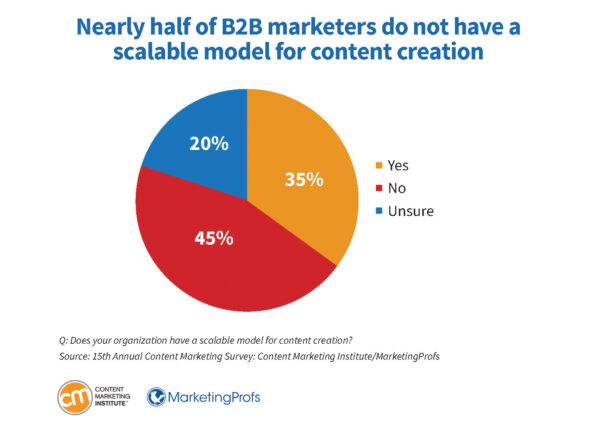
Andi Robinson, content strategist at Hijinx Marketing, explains why this failure to have and integrate tech capabilities holds B2B marketers back:

Content Strategist
Hijinx Marketing
Companies that have not taken the time to develop a robust and scalable content creation framework risk bottlenecks in their process, content that is not aligned to organizational and marketing strategy, and audience-facing brand inconsistencies.
Having a structured, scalable content creation process leads to greater content consistency and quality, more efficient use of resources, and better audience engagement.
On the brighter side, we followed up with those who have scalable models to ask if those models create the desired outcomes. Forty-one percent say they do. Slightly more than half (53%) say no, but we’re getting there, and just 6% say no, we have a long way to go.
B2B marketers struggle to measure content’s impact
Year after year, we hear marketers say how hard it is to prove the impact of their work. Let’s dig in to where they struggle.
We asked the B2B marketers (96%) who say they measure their content performance to indicate their agreement with the following: “Our organization measures content performance effectively.”
About half (51%) say they strongly or somewhat agree. Fifteen percent neither agree nor disagree. Twenty-three percent somewhat disagree, and 11% percent strongly disagree. So, the struggle is real for at least a third to half of marketers.
We asked B2B marketers what challenges their team faces while measuring content performance. Fifty-six percent say difficulty attributing ROI to content efforts. The same number cite difficulty tracking customer journeys.
Other challenges include:
- Inability to tie performance to business goals (44%)
- Insufficient resources or budget (41%)
- Lack of clear marketing goals/KPIs (39%)
- Data silos within the organization (37%)
- Limited access to advanced analytics tools (33%)
- Complex or inadequate reporting systems (29%)
- Inability to extract valuable information from data/analytics (29%)
- Lack of data skills/talent (25%)
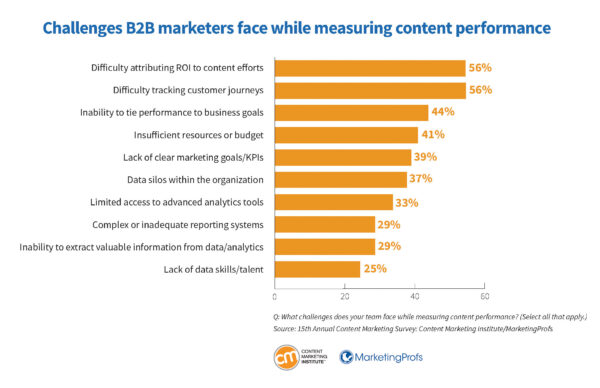
Amy Higgins, director of content strategy at Cloudflare, offered her take on why it’s so hard:

Director of Content Strategy
Cloudflare
Many marketers have a hard time calculating the ROI of their content initiatives because they don’t count both the creation and the distribution of their content. Most look only at the distribution costs alone.
It takes time to create content — whether the hours you pay an agency or your in-house team, their time costs money. Many people forget that and will only look at an agency invoice or the distribution spend. That means they are only calculating a portion of their content investment.
AI use trends
When it comes to AI use in B2B content marketing, we found many marketers experimenting, but few incorporate it into daily operations. That’s one area where top performers have pulled ahead of their peers. I’ll get into that shortly. For now, let’s look at a few findings.
Eighty-one percent of B2B marketers tell us their teams are using generative AI tools — that’s a jump up from 72% the previous year.
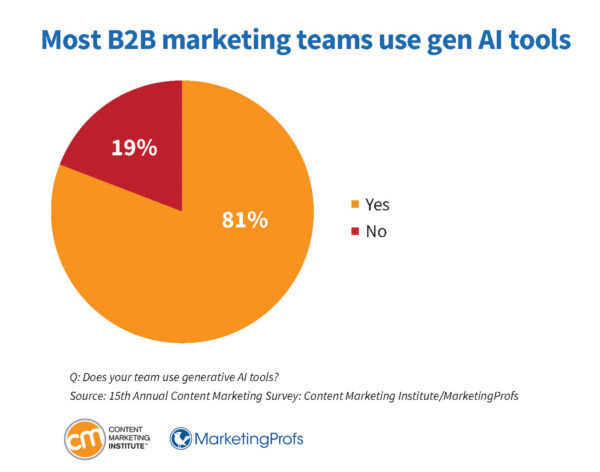
Marketers who don’t use AI cite accuracy concerns
We asked the few marketers who don’t use generative AI tools why. They cite these reasons:
- Accuracy concerns (35%)
- Corporate mandates not to use (28%)
- Copyright concerns (26%)
- Lack of training (22%)
- Lack of understanding (19%)
- No need/no use for gen AI (17%)
- Other (14%)
- Unsure (13%)
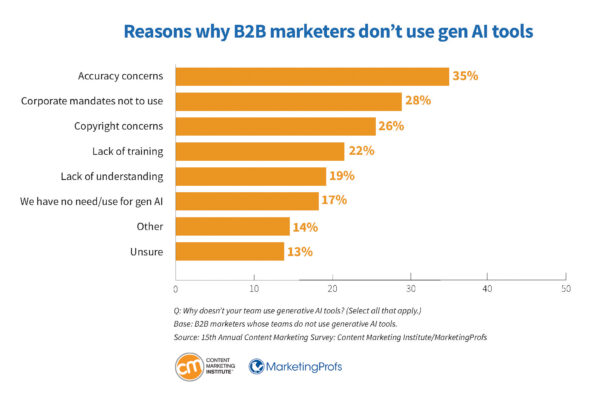
Many teams experiment, few integrate it
Most teams (54%) take an ad hoc approach to AI (i.e., they’re experimenting but not necessarily applying it widely). Another 27% report their teams don’t formally use AI, but individual staff members may choose to use it. Only 19% of B2B marketers say AI is integrated into their daily processes/workflows.
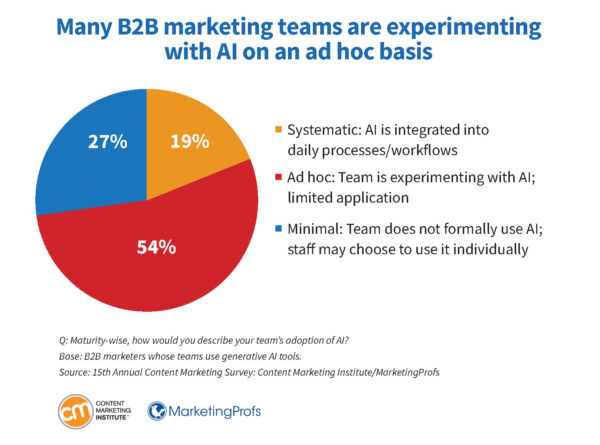
How can B2B marketers move the needle on AI integration? Pam Didner, author of The Modern AI Marketer, suggests these elements:

Author
The Modern AI Marketer
- Train with show and tell. Show what AI can do in real time. Give examples of how different job functions can use AI.
- Incorporate AI into your processes or workflows. Identify specific, repeatable tasks where AI can seamlessly fit, reducing the need for experimentation. If necessary, building custom AI tools or integrating existing platforms can help more consistent use.
- Advocate for it: C-suite executives and department heads must actively champion AI adoption. Their support is vital to fostering a culture of innovation, encouraging teams to move beyond occasional experimentation.
More B2B marketers have AI guidelines than last year
The number of B2B marketers whose organizations lack AI usage guidelines dropped to 45%, down from 61% last year.
Well over a third (38%) say their organization has AI guidelines, while nearly a quarter (23%) say their marketing team has guidelines. (Respondents could select both options.) Three percent are unsure if guidelines exist.

What AI guidelines cover
The respondents’ generative AI guidelines address a range of topics. Acceptable uses in content marketing topped the list, cited by 78%. Other areas include:
- Security measures specific to using generative AI (66%)
- Unacceptable uses of generative AI in content marketing (66%)
- Data-handling guidelines for generative AI platforms/output (64%)
- Purpose/objectives for using generative AI in marketing (58%)
- Transparency (i.e., disclosing when content is generated by AI) (48%)
- Legal/copyright recommendations (47%)
- Mitigating bias in generative AI output (29%)
- Real-world applications for generative AI (27%)
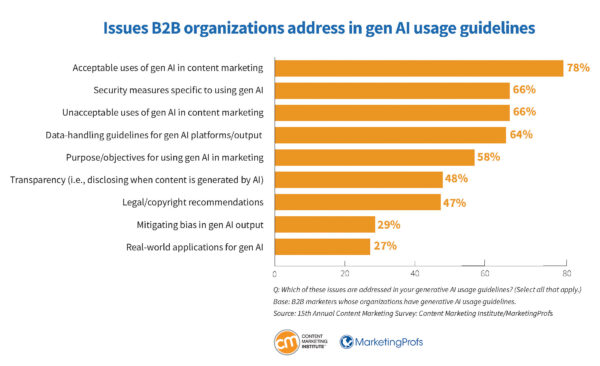
Most still use free AI tools
As in the previous year, most B2B marketers working with generative AI use free tools (88% vs. 91% the previous year). Forty-nine percent (up from 39% the previous year) use AI tools in their content creation/management systems, and 32% (up from 27% the previous year) pay for tools.
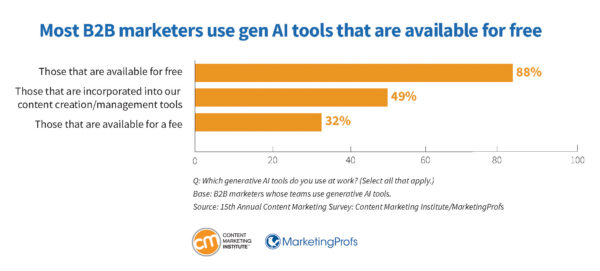
Do B2B marketers trust generative AI’s outputs?
We wondered how much trust B2B marketers place in generative AI’s outputs. It turns out that only 4% report a high level of trust. Most (67%) have a medium level of trust, and 28% percent say they have a low level of trust. Just 1% percent don’t trust AI output.
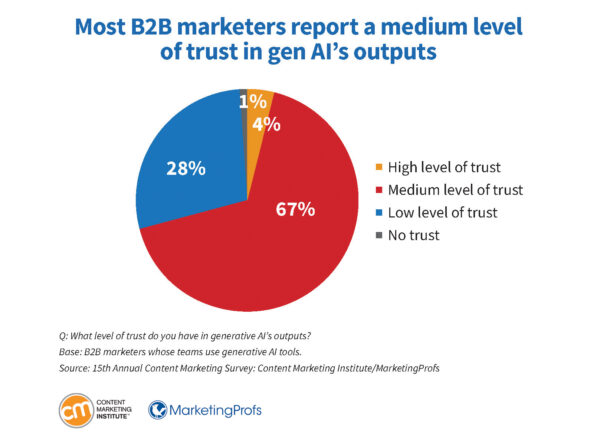
AI content quality is doubted
What about the quality of content generated by AI? That gets mixed reviews. Only 17% rate it as excellent or very good. But 44% say the output is good, and 35% say it’s fair. Only 4% percent rate it as poor.

Erika Heald, fractional head of content and founder at Erika Heald Marketing Consulting, explains why generative AI content underwhelms:

Founder
Erika Heald Marketing Consulting
Very few companies have comprehensive content governance programs in place, starting with defining their unique brand voice and how that affects the content they create and how they communicate with the communities they serve.
When combined with a detailed content style guide, content templates that make it clear what good content looks like, and agreed-upon workflows, content governance is what gives AI tools the context they need (just like humans) to create truly exceptional content.
Almost half of B2B marketers who use gen AI have more efficient workflows
Half of B2B marketers (51%) who use generative AI are noticing fewer tedious tasks as a result. Forty-five percent see more efficient workflows, 42% experience improved content optimization, and 38% see improved creativity. Far fewer see the following effects of generative AI use:
- Job anxiety (18%)
- Changing job requirements (16%)
- More personalized content (14%)
- Lower-quality content (13%)
- Employee layoffs (2%)
- Employee hires (2%)
- Other (5%)
Only 8% say AI has no impact.
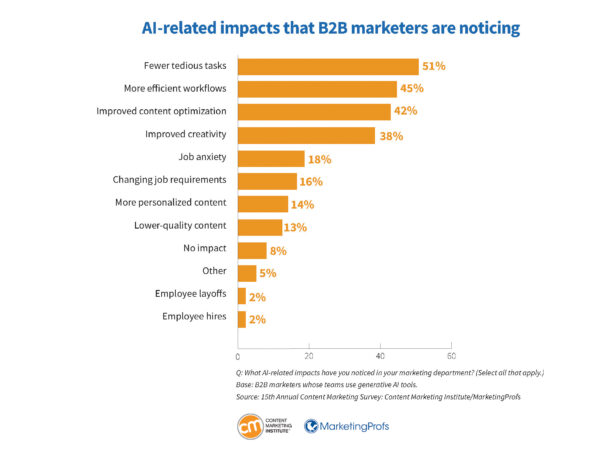
More than half prioritize AI-powered automation in 2025
When we asked B2B marketers how their organizations will prioritize AI-powered automation in 2025, 56% indicate it would be a high or medium priority. Twenty-one percent say it’s a low priority, and 11% don’t rate it as a priority, with 12% unsure of what will happen in 2025.
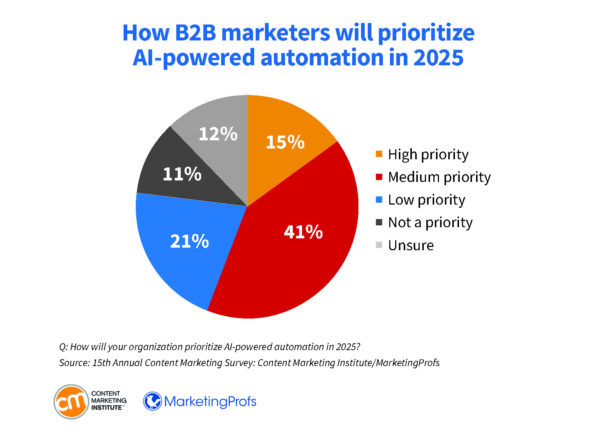
Again, MarketingProfs’ Ann Handley has some thoughts:

Chief Content Officer
MarketingProfs
Let’s go back to that earlier stat that showed how 43% of B2B marketers struggle with differentiating their content from their competitors. We struggle standing out in the sea of same. Yet, at the same time, 56% of B2B marketers are looking to prioritize AI-powered automation in 2025.
The question is: What are we automating? Let’s be smart about it.
Actually, here’s a plea from me: Use AI to automate the boring stuff that gets in the way of creativity. Use it to free up time to be more strategic and creative. Don’t offload your creativity to AI because next year … that 43% is going to increase in the 2026 version of this report. (FOREBODING SWELL OF MUSIC.)
Content and marketing goals
As we’ve seen in past years, content marketing helps most B2B marketers at the top of the funnel, with 87% reporting that it helped them create brand awareness in the last 12 months. Seventy-four percent say it helped generate demand/leads; 62% say it nurtured subscribers/audience/leads; 52% say it grew loyalty with existing clients/customers; and 49% say it helped generate sales/revenue. Thirty-seven percent say content marketing helped grow a subscribed audience, and 9% say it reduced customer support costs.
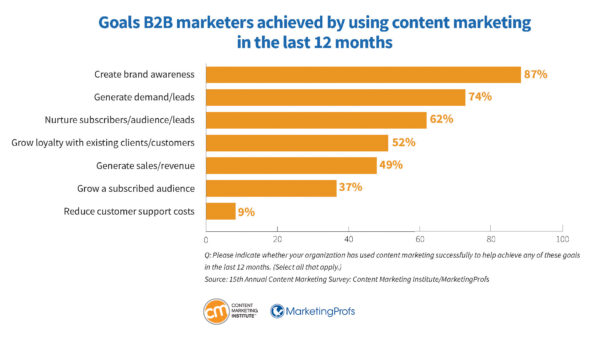
Success factors
On to what you can learn from the most successful marketers.
Each year, we ask, “How would you characterize the success of your organization’s content marketing approach in the last 12 months?” (Success is defined as achieving your organization’s desired/targeted results.)
This year, 22% of B2B marketers characterize the success of their content marketing as extremely or very successful. Fifty-four percent report moderate success and 21% feel minimally or not at all successful. Three percent are unsure.
We segmented the responses from marketers who rate their organizations as extremely or very successful and dubbed them as the top performers. We looked at what they do differently from their peers and explored the factors they attribute to their success.
What the most successful do
How do the most successful content marketers differ from their less successful peers? Top performers are more likely to:
- Think the size of their content marketing team will grow in 2025.
- Rate their content strategy is extremely or very effective.
- Have the right technology to manage content across the organization.
- Have a scalable model for content creation.
- Say their scalable model is creating the desired outcomes.
- Do a better job measuring content performance effectively.
- Use content marketing successfully to generate demand/leads, nurture subscribers/audiences/leads, grow loyalty with existing clients/customers, and generate sales/revenue.
Regarding AI, little difference existed last year between top performers and their peers. That changed this year, as top performers pulled ahead of their peers in some areas, including:
- Existence of organizational guidelines for generative AI use
- Integration of AI into their daily processes/workflows
- Realization of more efficient workflows from AI
- Improved content optimization from AI
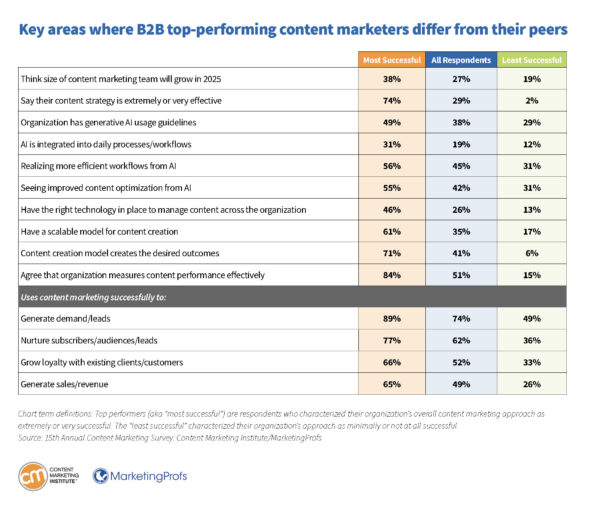
Reasons for top performers’ success
Like the previous year, the top performers attribute their success mostly to understanding their audience (82%).
Other factors mentioned include:
- Produce high-quality content (77%)
- Possess industry expertise (70%)
- Have high-performing team members (69%)
- Set goals that align with their organization’s objectives (62%)
- Measure and demonstrate content performance effectively (53%)
- Have a documented strategy (47%)
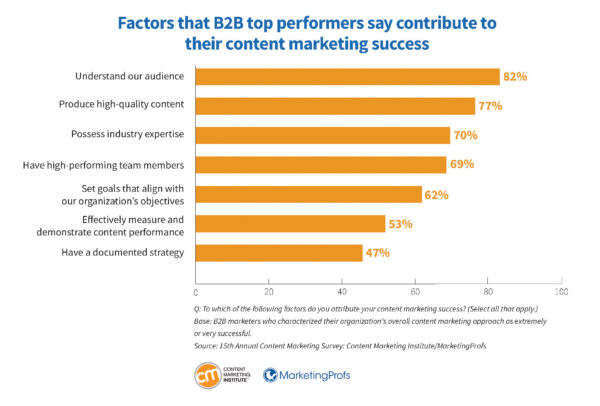
We asked B2B marketers with moderate or lower levels of success, “What would it take to improve your content marketing success?” These comments illustrate some common themes in their responses:
- “More human resources and fewer rush requests from other teams.”
- “Better strategy, more focused goals. Prioritizing the various internal clients’ needs vs. ROI.”
- “A larger team, more/clearer direction from leadership about the role of marketing within the organization, more resources.”
- “Fewer silos and more coordination between teams.”
- “More dedicated content repurposing process, buyer journey insights — creating more targeted content that aligns to each stage of the journey.”
- “Align the content marketing team’s strategy and goals with other teams that create content.”
- “Resources to generate more content and repurpose it effectively.”
B2B content tactics
Now that we’ve explored how B2B content marketers work, where they struggle, and how top performers differ, let’s turn to the kinds of content produced and where marketers get the best results.
Short articles are the most-used content type
We asked B2B marketers about the types of content, distribution channels, paid channels, and social media channels used over the last 12 months. The data didn’t show any notable differences between the top performers and the rest of the marketers.
The list of content types and usage looks almost identical to last year’s. Ninety-two percent used short articles/posts, 76% used videos, 75% used case studies/customer stories, 69% used long articles/posts, 57% used data visualizations/visual content, and 51% used e-books/white papers. Less than half of B2B marketers used product technical/data sheets (41%), research reports (36%), and interactive content (27%).
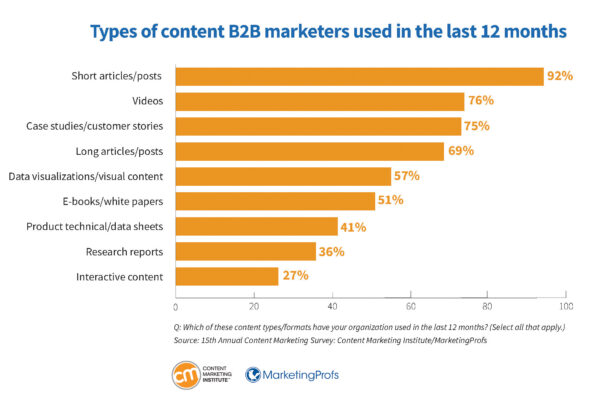
Videos are rated most effective
Last year, B2B marketers said case studies/customer stories were the most effective types of content. This year, they say videos (58%), which came in second last year, are the most effective, followed by case studies/customer stories (53%), e-books/white papers (45%), research reports (45%), and short articles/posts (43%).
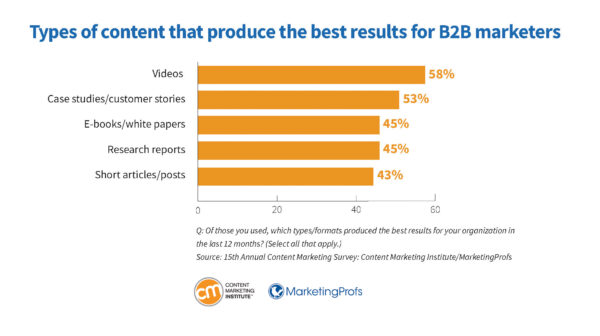
Almost all distribute content via social media and corporate blogs
As we saw with the content types, the distribution channel list looks almost identical to what we reported last year.
More than half used organic social media platforms (89%), blogs on corporate websites (84%), email newsletters (71%), email (63%), in-person events (55%), and webinars (55%). Fewer than half used digital events (40%), podcasts (27%), and microsites (26%).
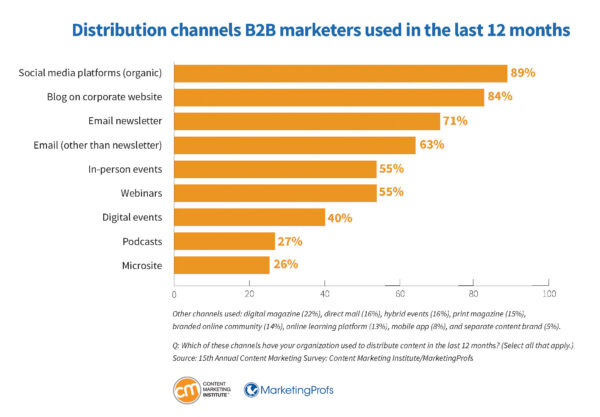
Other channels included digital magazines (22%), direct mail (16%), hybrid events (16%), print magazines (15%), branded online communities (14%), online learning platforms (13%), mobile apps (8%), and separate content brands (5%).
Podcast use saw a slight decrease from the previous year (27% vs. 30%). Why aren’t more B2B marketers using this format?
A. Lee Judge, co-founder and chief marketing officer of Content Monsta, offers his take:

Co-founder and CMO
Content Monsta
Most businesses view podcasts only as a channel, missing the chance to use them as a content source. Podcasts produce media-rich and engaging content that performs well across multiple channels, including social media, blogs, and newsletters.
Like other content marketing, tracking direct attribution from podcast engagement to closed deals is hard. The way podcasts are consumed makes measurement that much more difficult.
Under pressure to show ROI, valuable marketing programs like podcasts get cut due to imprecise measurement. And marketers often focus on the wrong KPIs for podcasts.
Podcasting for business should be viewed as a content engine and a relationship builder. Traditional metrics miss both. Businesses don’t need a large podcast audience — they need the right audience. So, instead of tracking downloads and subscribers, they should measure content engagement, brand mentions, lead generation, and business relationships.
In-person events and webinars most popular and effective distribution channels
Like the previous year, B2B marketers say in-person events (52%) and webinars (51%) are the most effective distribution channels, followed by email (42%), organic social media platforms (42%), blogs on corporate websites (41%), and email newsletters (37%).
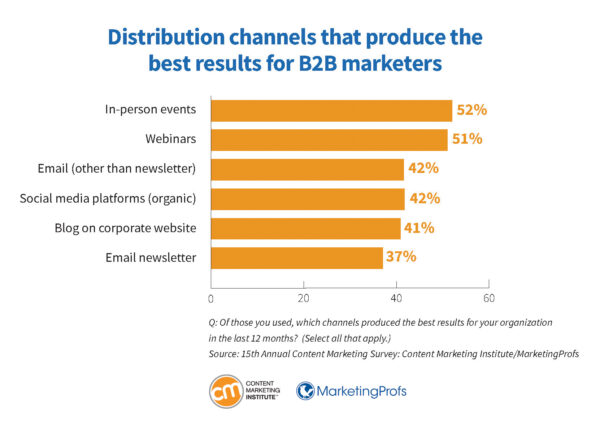
84% use paid channels; social media advertising tops the list
Eighty-four percent of B2B marketers say they use paid channels. Of those, 73% use social media advertising/promoted posts. More than half also use search engine marketing/pay-per-click (64%), digital display advertising (62%), and sponsorships (62%). Fewer than half use native advertising/sponsored content (34%), partner emails (30%), print display advertising (21%), influencer marketing (16%), and other (5%).
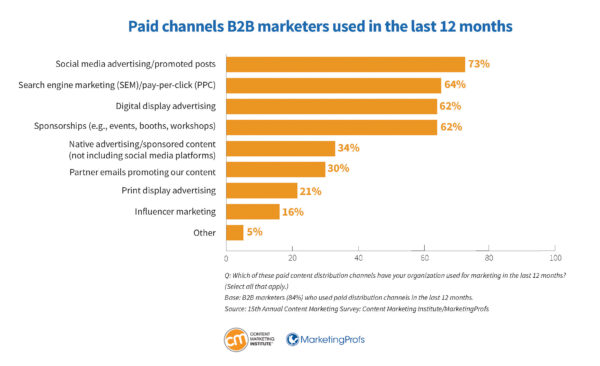
Search engine marketing produces best results among paid channels
As they did the previous year, B2B marketers said SEM/PPC was the paid channel that produced the best results for their content marketing (61%), followed by social media advertising/promoted posts (49%), sponsorships (48%), and digital display advertising (35%).
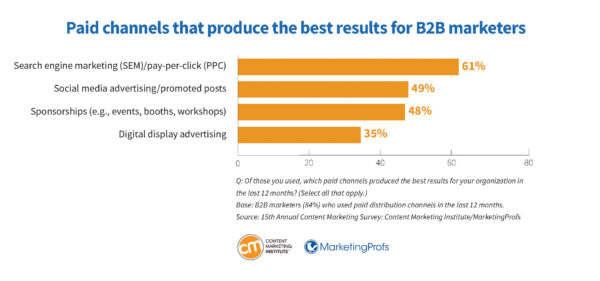
B2B marketers consistently cite LinkedIn as the social media platform that delivers the best value for their organization, and this year is no different. Eighty-five percent say LinkedIn delivers the best value, followed by 28% who say Facebook, 22% who cite YouTube, and 21% who say Instagram. Only 7% mention Twitter and 3% say TikTok, with responses nearly identical to the previous year.
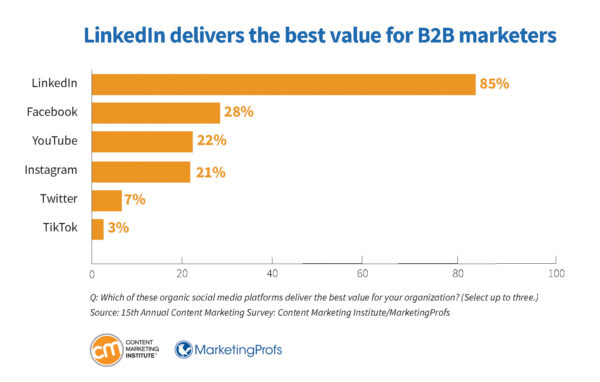
Heike Young, head of content and integrated marketing at Microsoft, says LinkedIn remains a gold mine for B2B marketers:

Head of Content and Integrated Marketing
Microsoft
Think you need to be overly formal, corporate, and professional on LinkedIn? Nope. Nowadays, creator-led campaigns and vertical videos bring a funnier and less stodgy flavor to the LinkedIn feed. LinkedIn is ubiquitous with B2B audiences. Literally everyone is there. Now’s the time to stand out and reach your audience where they are with content that’s refreshingly human and real.
The brands that do LinkedIn right today will wield huge influence over the next year.
Where did social media use increase?
With LinkedIn delivering the best value, it’s unsurprising that 68% of marketers increased their use of it in the last 12 months. What else is up?
- 31% increased their use of YouTube
- 27% increased their use of Instagram
- 20% increased their use of Facebook
- 9% increased their use of TikTok
- 6% increased their use of Reddit
- 6% increased their use of X
X’s overall use declines
B2B marketers’ use of organic social media platforms looks much like it did the previous year. The only sizeable decrease came from X: 39% say they don’t use X. Last year, only 27% said they didn’t use it.
Only 15% say they use Reddit. Considering its recent debut in Google’s search results, it will be interesting to see what happens over the next year on that platform.

Budgets and spending trends
Sixty-three percent of B2B marketers say they have knowledge of their organization’s budget/budgeting process for content marketing. Among those marketers, 46% think their content marketing budget will increase in 2025 when compared with 2024 (last year, 45% thought their budget would increase). Forty-one percent think their budget will stay the same, 8% expect it to decrease, and 5% are unsure.
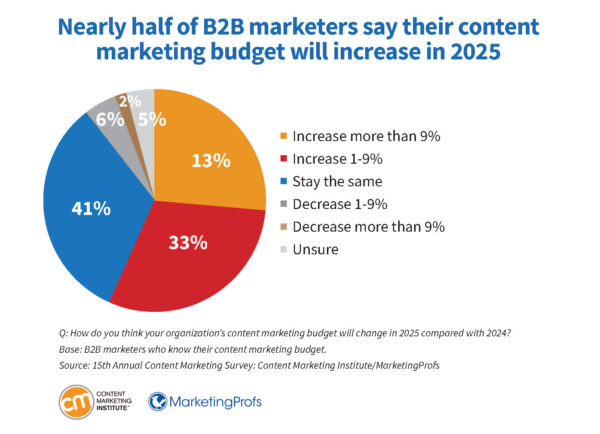
AI investments join the list of spending areas for 2025
As we saw in the last two years, the majority of B2B marketers (61%) think their organization will increase investment in videos in 2025. Budgets for AI for content optimization/performance (40%) and AI for content creation (39%) were new areas of investment on the list this year.
The other investment areas were cited in numbers similar to last year except for in-person events, which decreased to 35% this year vs. 47% last year.
To summarize, 61% think their organization will increase investment in videos in 2025, followed by thought leadership content (52%), AI for content optimization/performance (40%), paid advertising (40%), AI for content creation (39%), in-person events (35%), webinars (32%), building an online community (27%), digital events (21%), and audio content (20%).
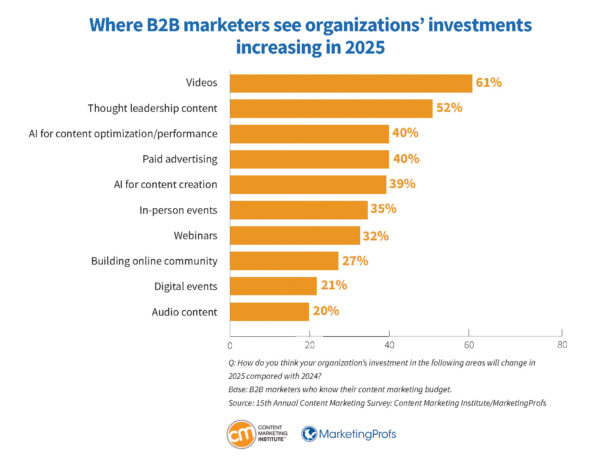
1 in 4 think their team will grow in 2025
In a new question, we asked B2B marketers to predict whether their teams would grow, stay the same, or decrease in the coming year. Almost two-thirds (64%) expect the size of their content marketing team will stay the same in 2025; however, 27% think their team will grow. Only 6% think the team will decrease, and 3% are unsure. Among the top performers, 38% think their teams will grow.
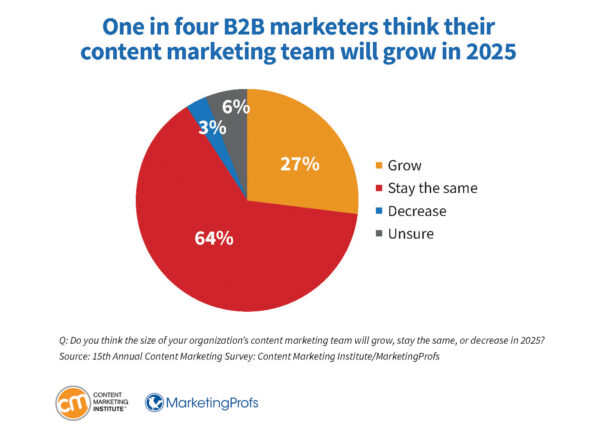
When we asked why they think their teams will increase in 2025, several themes emerged:
- Content importance: When the organization sees value in content, more resources are needed to manage and produce high-quality content.
- Integration and collaboration: Many marketers expect to integrate content marketing more fully within their organizations to break down silos and create more cohesive teams.
- Gaps and demands: Marketers reported plans to fill the content gaps for various audience segments.
- Market demand: More content staff can capitalize on market opportunities and meet customer needs.
- Organizational growth: Some organizations are expanding operations and entering new markets.
Here are some of the B2B marketers’ comments:
- “Demand is high, and we have a unique proposition in the market.”
- “Increasing understanding of the power of content.”
- “Content has become more relevant to the business in the last few years.”
- “Our business is growing, and our need for content has increased. Content has been a significant part of our organic growth.”
- “Good content is more important than ever, so our needs will continue to grow.”
- “Higher demand for increasingly diverse content.”
While such growth will be exciting, it will be important to ensure that these teams have the leadership, goals, strategies, resources, budgets, scalable content models, and technologies they need for success.
Action steps
So, how can B2B content and marketing teams act on these benchmarks and trends? I asked CMI’s Robert Rose to provide some advice. Here’s what he said:
“Do. Or do not. There is no try.”
— Yoda

Chief Strategy Advisor
Content Marketing Institute
One of the more common situations I see B2B marketing teams facing today is the perennial state of “fixing things.” The CMS never got fully implemented. The “phase X” of marketing automation doesn’t work the way it should. Customer data is inaccessible. So are the analytics. The new CMO is reorganizing and auditing the teams. Everyone’s struggling to keep up with content demand, so we’re trying to fix our production tools. And we’re all busy experimenting with AI.
On many teams, 100% of time and resources go to fixing or maintaining things. When new ideas come along, the team either can’t do them or sighs wearily and says, “OK, we’ll try.”
But the most successful teams don’t try. They do these things:
- Create a content orchestration approach. Fixing the communication, collaboration, and alignment among the teams handling content creation, consumption, publishing, and measurement isn’t glamorous. Still, here’s a truth about one company that now seems to effortlessly produce compelling content that wins all the awards. It once spent years tackling the non-glamorous work of creating cross-team governance, workflows, and standards. It was tough and messy, and it required a shift in working habits. Today, it’s operating on an entirely different level.
- Take a structured approach to content and marketing innovations. Letting every team member experiment with AI and other innovations is like setting dogs or cats loose in a pet food store to find a workable approach to better animal nutrition. You won’t get efficiency by adding “experiment” to everyone’s workload or by filling every spare moment with a “making marketing better” meeting. Instead, come together (see previous point) to collaborate on and commit to a few strategic bets. They might still fail, but you’ll learn why they failed rather than just saying, “We didn’t give it enough resources.”
- Stop doing some things. Many marketing challenges are caused by institutional momentum. One company I worked with created 250 PDFs for thought leadership in a year — only 63 of them earned more than 20 downloads. Teams increasingly focus on task-based outputs rather than meaningful outcomes. Stop producing what doesn’t work, end activities that don’t contribute to targeted outcomes, and quit measuring what doesn’t align with overall objectives.
Marketing teams must let go of the mindset that being 100% busy is a good thing. It isn’t. There will always be things to fix and maintain. But the only way out of meh content and marketing results isn’t to seek new resources to supplement the repair and maintenance work.
To be remarkable, you must create space for the possibility of creating something remarkable.
As I’ve said to many clients in the last six months, the decisions you make are not nearly as important as making them.
Stop trying things. Do things.
Methodology
The 15th annual content marketing survey was conducted by Content Marketing Institute and MarketingProfs. The survey was fielded between June 25 and August 16, 2024, and was sponsored by The MX Group. The survey drew 1,186 global responses. This article reports on the 980 B2B respondents, mostly from North America.
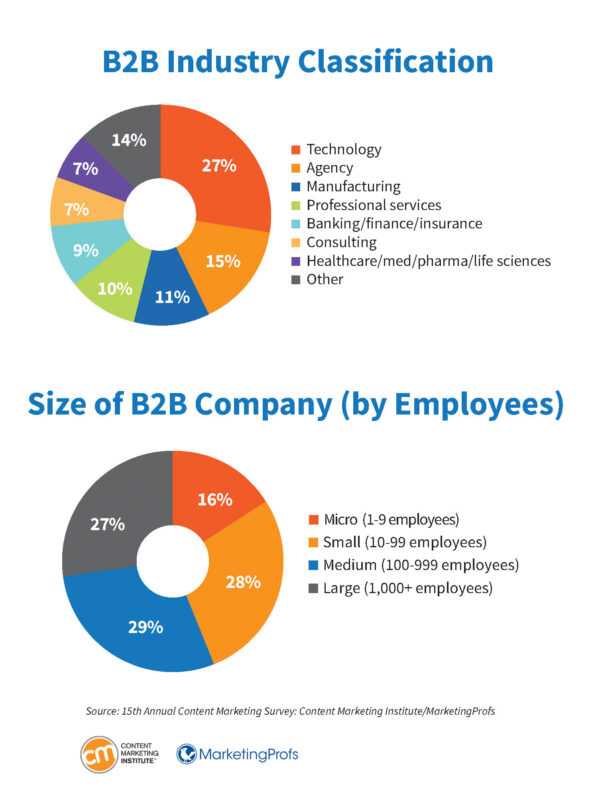
The industries represented include:
- Technology (27%)
- Agency (15%)
- Manufacturing (11%)
- Professional services (10%)
- Banking/finance/insurance (9%)
- Consulting (7%)
- Health care/med/pharma/life sciences (7%)
- Other (14%)
The B2B marketers surveyed work in these organizational sizes:
- One to nine employees (16%)
- 10 to 99 employees (28%)
- 100 to 999 employees (29%)
- 1,000-plus employees (27%)
Thanks to the survey participants who made this research possible and everyone who helps disseminate these findings throughout the marketing industry.
About Content Marketing Institute

Content Marketing Institute (CMI) exists to do one thing: Advance the practice of content marketing through online education and in-person and digital events. We create and curate content experiences that teach marketers and creators from enterprise brands, small businesses, and agencies how to attract and retain customers through compelling, multichannel storytelling. Global brands turn to CMI for strategic consultation, training, and research. Organizations from around the world send teams to Content Marketing World, the largest content marketing-focused event, the Marketing Analytics & Data Science (MADS) conference, and CMI virtual events, including ContentTECH Summit. Our community of 215,000-plus content marketers share camaraderie and conversation. CMI is organized by Informa Connect. To learn more, visit www.contentmarketinginstitute.com.
About MarketingProfs

More than 600,000 marketing professionals worldwide rely on MarketingProfs for B2B Marketing training and education backed by data science, psychology, and real-world experience. Access free B2B marketing publications, virtual conferences, podcasts, daily newsletters (and more) and check out the MarketingProfs B2B Forum — the flagship in-person event for B2B Marketing training and education at MarketingProfs.com.
About The MX Group

The MX Group is the second-largest independent B2B marketing agency in the U.S., with a mission to impact the marketplace for companies that impact the world. For over 35 years, we’ve created meaningful Market Experiences for national and global B2B brands. Our clients are leaders and innovators in the automotive, energy and utilities, financial services, food, oil and gas, industrial, manufacturing, packaging, technology and SaaS sectors as well as trade associations. Whether a client is an established brand or a startup, we have the people and perspectives to be a strong partner that makes a difference. For more, visit themxgroup.com.
Cover image by Joseph Kalinowski/Content Marketing Institute
